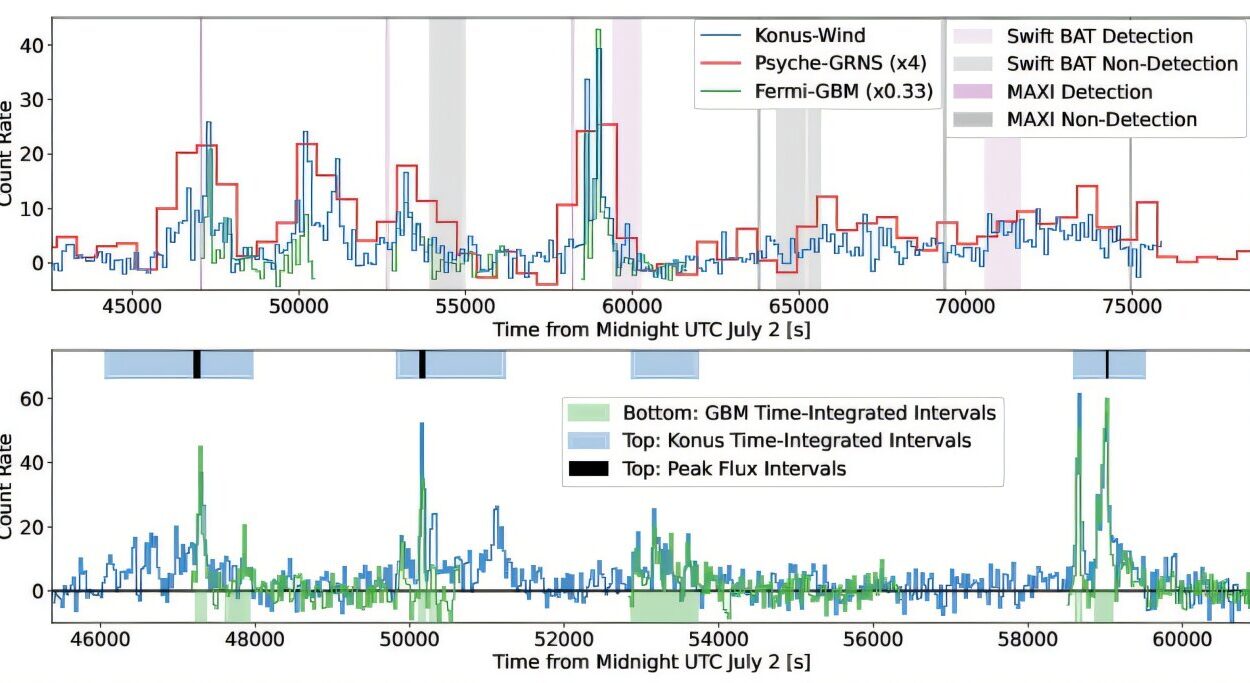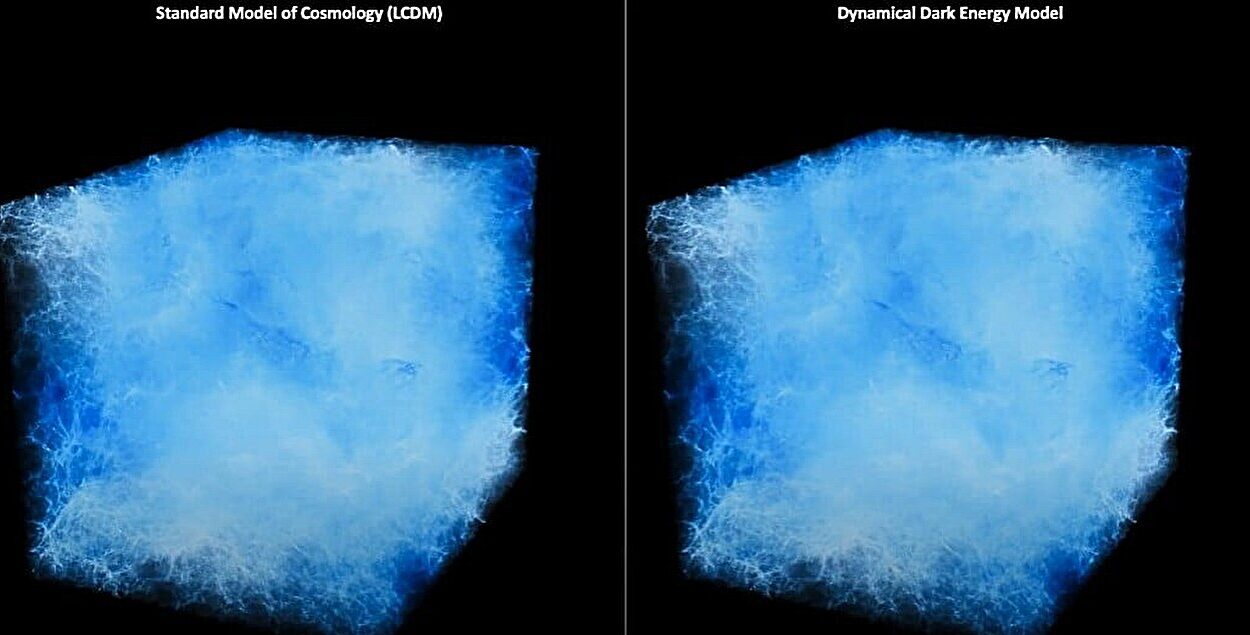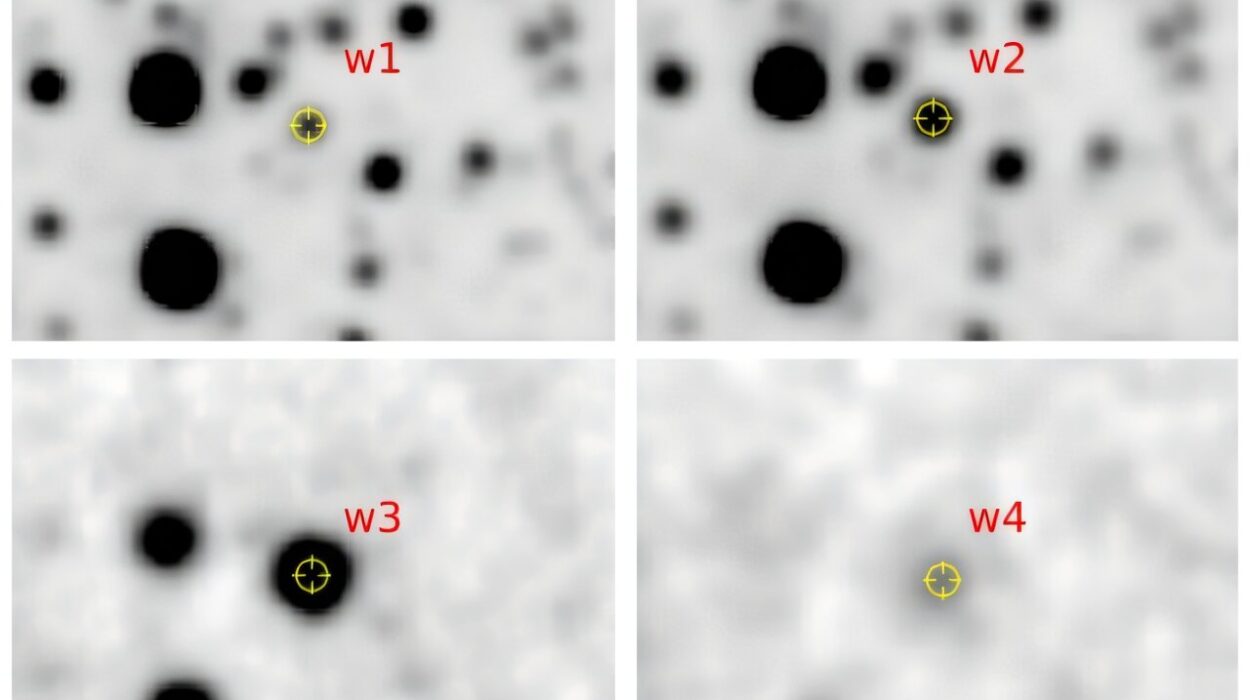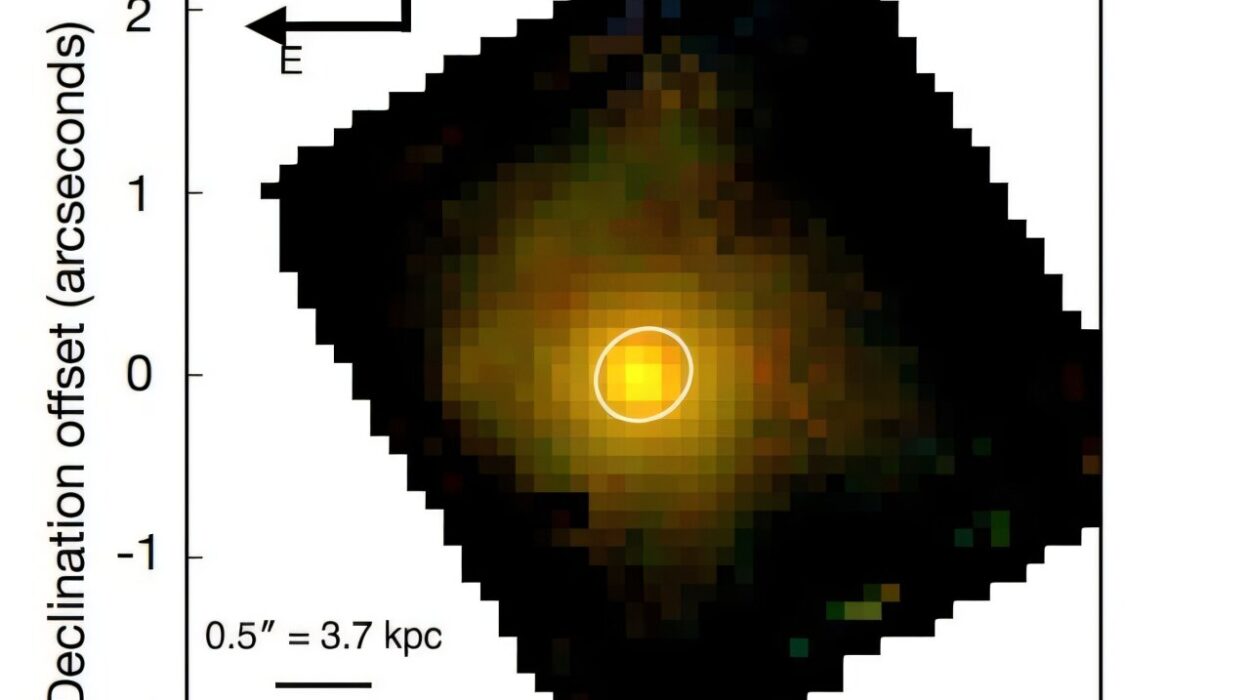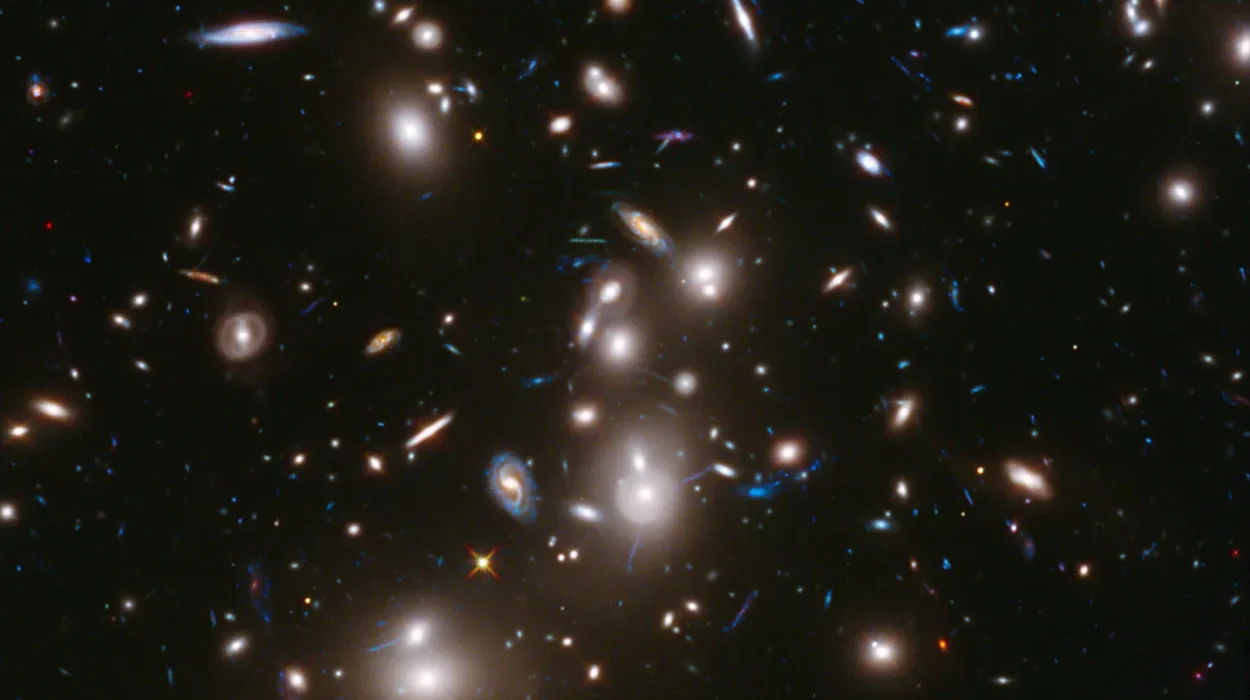It’s 280 million years after the Big Bang. The universe is dark, just beginning to light up with the first stars and galaxies. At that time, no planets circle stars. No galaxies, as we know them, wheel in majestic spirals. Black holes are just beginning to awaken, supernovae are rare but powerful, and the cosmos is a stew of primordial hydrogen and helium.
Now, 13.5 billion years later, we have a telescope perched at the edge of Earth’s shadow—an instrument with a golden eye capable of piercing that ancient darkness.
The James Webb Space Telescope (JWST), humanity’s most ambitious space observatory, has done it again. It has caught the light of a galaxy—MoM-z14—that formed just 280 million years after the Big Bang, making it the most distant and oldest confirmed galaxy ever observed. This discovery isn’t just another notch in the telescope’s cosmic belt. It’s a whisper from a time so early in the universe’s history that, until recently, astronomers doubted whether galaxies that luminous even existed back then.
And yet here it is: MoM-z14, a small, brilliant dot across time and space, telling us stories we never expected to hear.
A Gold Mirror and a Dream
For decades, astronomers dreamed of seeing into the universe’s “cosmic dawn”—the period after the Big Bang when the first stars and galaxies began to shine. But dreams met limitations.
The Hubble Space Telescope, a revolutionary tool in its own right, pushed our view into the near-infrared. Its 2.4-meter mirror allowed us to see galaxies as they existed 500 million years after the Big Bang. That was impressive—but not enough. The earliest light in the universe is stretched, or redshifted, by the expansion of space itself. To see it, you need a telescope that can read deeply into the infrared spectrum. And to do that well, you need a much larger mirror and dramatically better detectors.
Spitzer was a dedicated infrared telescope, but with its 85-centimeter mirror, it couldn’t penetrate deep enough into cosmic time. The veil over the early universe remained mostly unlifted—until JWST.
Launched on December 25, 2021, the JWST brought a 6.5-meter segmented mirror, cryogenically cooled instruments, and detectors with extraordinary sensitivity. Designed to study four main themes—including the Assembly of Galaxies—it wasted no time delivering on its promise. Within weeks of starting science operations, it began to detect a surprising population of bright galaxies at redshifts greater than z = 10. In cosmic terms, it was as if we’d been reading the first chapter of a book and suddenly discovered there was a prologue—written in glowing hydrogen and starlight from the birth of the cosmos itself.
Mirage, Miracle, and MoM-z14
MoM-z14 wasn’t discovered by accident. It comes from the Mirage (or Miracle) survey, a dedicated spectroscopic campaign using JWST to hunt down the earliest galaxies in the universe. These surveys aim to confirm candidate galaxies that are suspected of having formed at very high redshifts—z > 10, which corresponds to less than 450 million years after the Big Bang.
The designation “z14” refers to MoM-z14’s redshift of z = 14.44, which corresponds to a time just 280 million years post-Big Bang. That’s a jaw-dropping observation. It’s like seeing the first flicker of fire in a cave before civilization has even begun.
Prior to JWST, astronomers believed the universe at this stage was largely devoid of galaxies, let alone bright, chemically complex ones. But now, that narrative is being rewritten. MoM-z14 is not just old—it’s remarkably luminous, a point-source galaxy glowing with energy and structure that defies previous expectations.
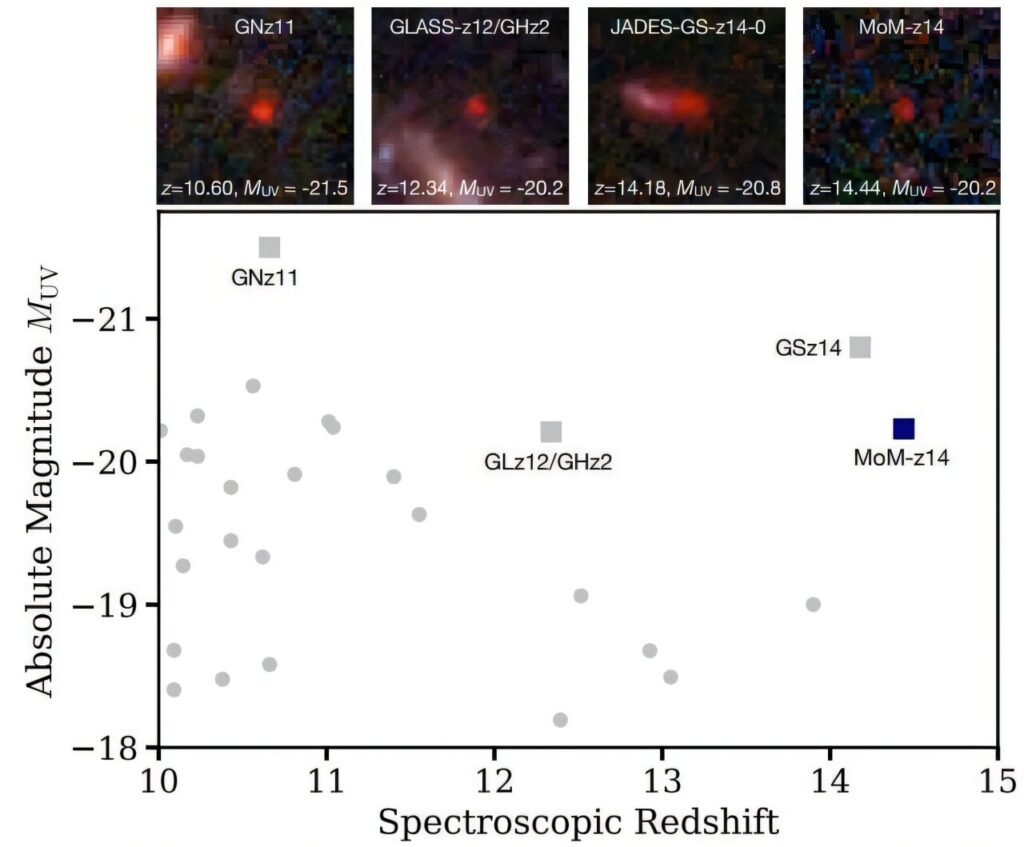
In a new study titled “A Cosmic Miracle: A Remarkably Luminous Galaxy at zspec = 14.44 Confirmed with JWST”, lead author Rohan Naidu of the MIT Kavli Institute and colleagues present their findings. The study, submitted to the Open Journal of Astrophysics and available on the arXiv preprint server, argues that this single detection represents a profound leap forward in our understanding of the early universe.
The Light of Ancient Stars
So what exactly is MoM-z14? What makes it different from other ancient galaxies?
The JWST’s spectroscopic analysis reveals that most of the light from MoM-z14 comes not from an active galactic nucleus (AGN)—a central supermassive black hole devouring matter—but from stars. This is critical. AGNs, though bright, are not representative of typical galaxy formation. If the light is stellar, then we’re seeing a galaxy populated by powerful, massive stars burning hot and fast, possibly the so-called Population III stars, which have long been theorized but never directly observed.
These stars are thought to be born from pristine hydrogen and helium, forged in the aftermath of the Big Bang. They live short, furious lives, exploding in supernovae that seed the cosmos with heavier elements—carbon, nitrogen, oxygen—the raw materials for future stars, planets, and life itself.
In MoM-z14, we may be witnessing the first generation of those stars in action. And it’s not just the starlight that’s telling us their story. It’s their chemistry.
A Fingerprint of Cosmic Ancestors
One of the most surprising features of MoM-z14 is its high nitrogen-to-carbon ratio—a chemical signature that sets it apart from typical galaxies and aligns it more closely with ancient stellar populations seen in Milky Way globular clusters.
This fingerprint suggests something extraordinary: that the processes shaping this early galaxy are similar to those that formed the oldest known stars in our galaxy. It’s a cosmic echo, a chemical throughline connecting the first luminous structures of the universe to the stars orbiting in the halo of the Milky Way today.
As the authors write, “Since this abundance pattern is also common among the most ancient stars born in the Milky Way, we may be directly witnessing the formation of such stars in dense clusters, connecting galaxy evolution across the entire sweep of cosmic time.”
In essence, JWST isn’t just observing a galaxy—it’s performing galactic archaeology, tracing the ancestry of modern stars back to their primeval ancestors.
The Mystery of Morphologies and Nitrogen
MoM-z14 isn’t alone in its uniqueness. The JWST has now found a pattern among ancient, bright galaxies: a division between point-like and extended sources. This morphological diversity appears to correlate with chemical differences. Compact sources, like MoM-z14, tend to be strong nitrogen emitters, while extended galaxies show nitrogen-poor spectra.
This discovery points to a potential size-chemistry bimodality—a division in early galaxies based not just on appearance but on the processes that shaped them. Perhaps compact galaxies underwent intense bursts of star formation in dense environments, producing both supermassive stars and high nitrogen yields. Perhaps extended galaxies grew more slowly, evolving through different mechanisms. The connection between morphology, chemistry, and evolution may become one of the next great frontiers in cosmology.
MoM-z14, with its small size and nitrogen-rich profile, may be the brightest example yet of this early, intense mode of galaxy formation.
Supermassive Stars and Runaway Collisions
Another hypothesis emerging from the study is that runaway stellar collisions in dense clusters might have produced supermassive stars—tens of thousands of times more massive than the sun. These exotic objects could be the precursors to the supermassive black holes we see in the centers of modern galaxies.
The idea is that in environments as compact and extreme as MoM-z14, stars are so tightly packed that gravitational interactions can trigger repeated mergers. The result is a giant star that shines intensely, lives briefly, and collapses into a massive black hole.
If this mechanism is confirmed, it could help explain a longstanding mystery in astronomy: how supermassive black holes formed so early in the universe’s history.
A Telescope for the Ages
JWST was designed to answer grand questions about the origin of galaxies, stars, and planets. But its early discoveries—including MoM-z14—have exceeded expectations. Astronomers once feared they’d struggle to find any galaxies at redshifts greater than z = 10. Now, they’re overwhelmed by a growing zoo of bright, chemically complex galaxies well beyond that threshold.
And yet, JWST may still be only scratching the surface.
As the paper notes, “JWST itself appears poised to drive a series of great expansions of the cosmic frontier. Previously unimaginable redshifts, approaching the era of the very first stars, no longer seem far away.”
This isn’t just hype. Every observation JWST makes pushes the cosmic curtain back a little further, bringing into view objects and epochs that existed before even our galaxy was born.
Looking Ahead: The Roman Telescope and Beyond
The scientific community is already looking toward the next frontier. NASA’s upcoming Nancy Grace Roman Space Telescope, scheduled for launch later this decade, will offer a wide-field view of the sky—perfect for finding hundreds more ancient galaxies like MoM-z14. Where JWST provides depth and detail, Roman will provide scope and context.
With a larger statistical sample, astronomers hope to move from isolated discoveries to broader theories about how the first galaxies formed, how stars assembled in the early universe, and how supermassive black holes arose so quickly.
In the meantime, JWST continues to reign as the king of cosmic time-travel, peering further into the early universe than anyone thought possible.
The Dawn Is No Longer Silent
What does it mean that we can now observe a galaxy from just 280 million years after the Big Bang?
It means that the earliest parts of our story—the chapters we once thought were lost to darkness—are suddenly visible. MoM-z14 is more than a bright dot on a spectral chart. It is evidence that galaxies formed earlier, faster, and with more complexity than any model had confidently predicted. It challenges our understanding of when the cosmic web was woven, how the universe enriched itself with heavy elements, and how the seeds of modern galaxies were planted.
And it reminds us that in a universe 13.8 billion years old, the past isn’t dead—it’s glowing.
Reference: Rohan P. Naidu et al, A Cosmic Miracle: A Remarkably Luminous Galaxy at zspec=14.44 Confirmed with JWST, arXiv (2025). DOI: 10.48550/arxiv.2505.11263

